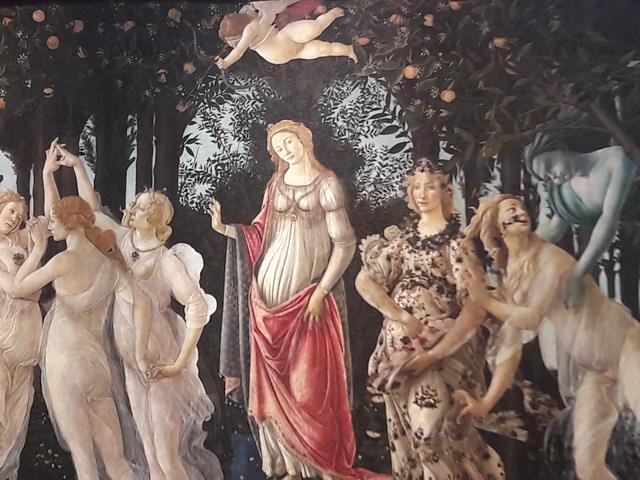Spring

This painting, generally known as Primavera [or 'Spring'], shows nine figures from classical mythology advancing on a flowering lawn in a grove of orange and laurel trees. In the foreground on the right, Zephyrus embraces a nymph named Chloris before taking her; She is later depicted after her transformation into Flora, the goddess of spring. The center of the painting is dominated by the goddess of love and beauty, Venus, dressed chastely and distanced from others, and by a blindfolded Cupid, shooting his arrow of love.
On the left, the three Graces, minor goddesses with Venus-like virtues, are shown dancing in a circle. The composition is closed by Mercury, messenger of the gods, recognizable by his helmet and winged sandals, while touching a cloud with his staff.
Although the complex meaning of the composition remains a mystery, the painting is a celebration of love, peace and prosperity. The dark color of the vegetation is due in part to the aging process of the original pigment, but is lightened by the abundance of fruits and flowers. At least 138 species of different plants have been identified, all accurately portrayed by Botticelli, perhaps using herbaria. The attention to detail confirms the artist's commitment to this piece, which is also evident in the skill with which the paint has been applied.
It is painted on a poplar wood support and towards the end of the 15th century, it was located in the house on Via Larga (present-day Via Cavour) that belonged to the heirs of Lorenzo di Pierfrancesco de' Medici, cousin of Lorenzo the Magnificent. It was hung over a lettuccio, a type of chest with a back that was often among the furniture in noble Renaissance houses. It was later moved to Villa di Castello, where Giorgio Vasari (1550) describes it together with the birth of Venus.
© Tourblink